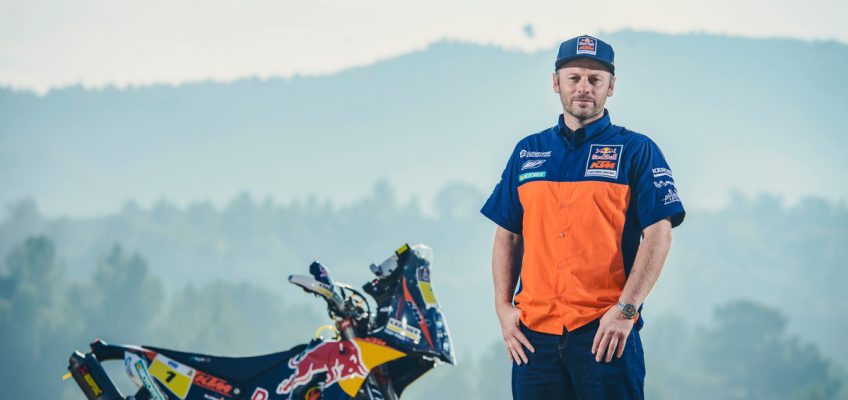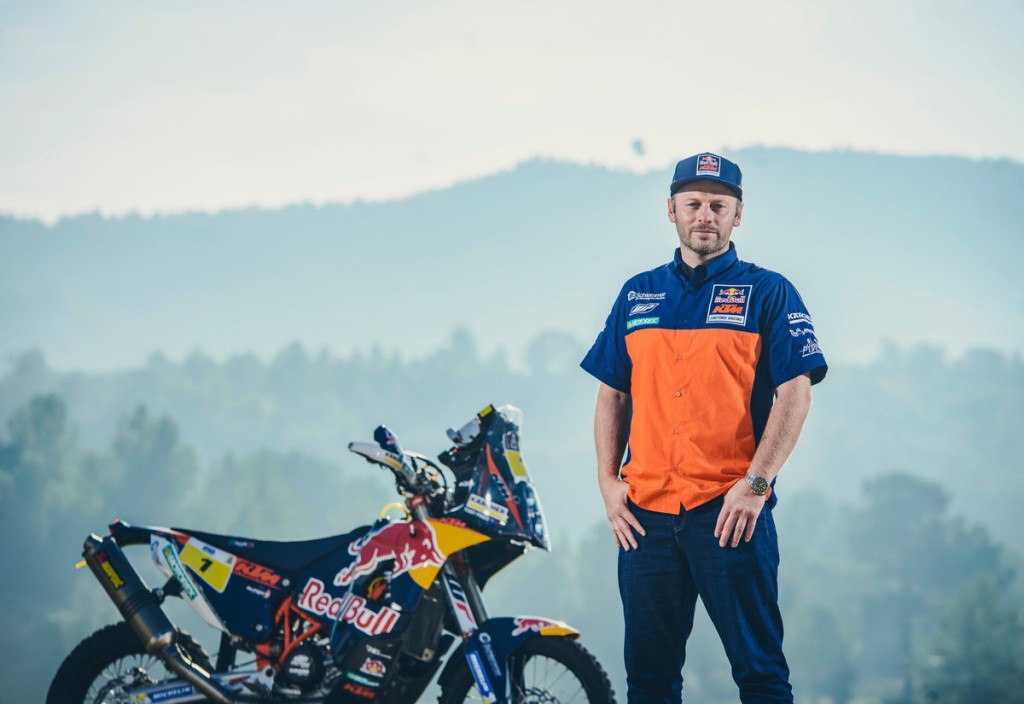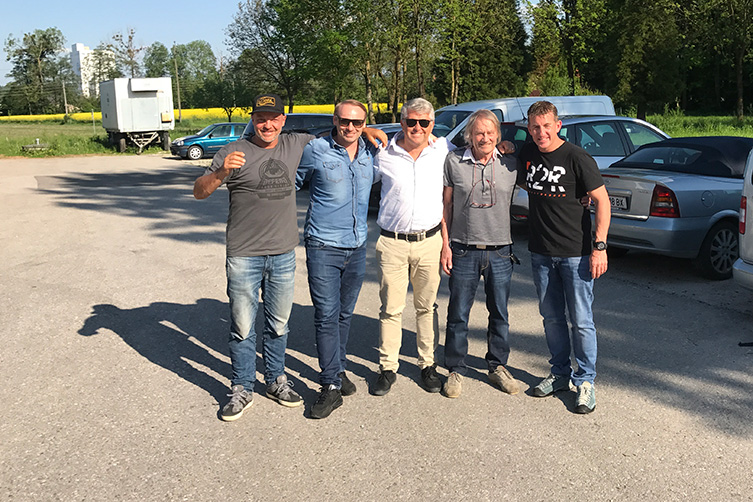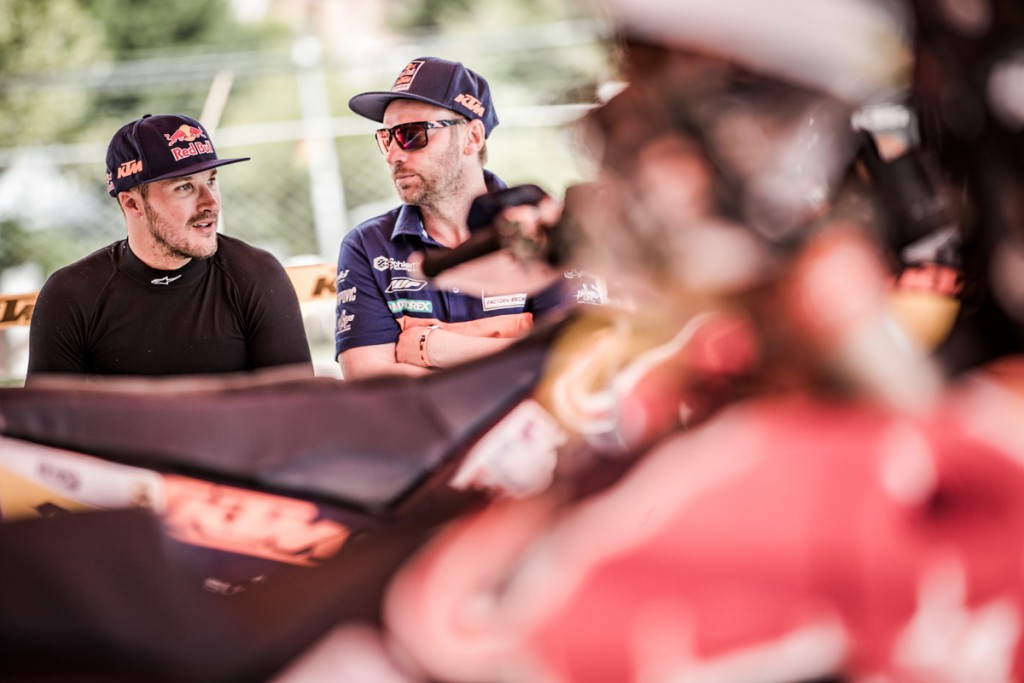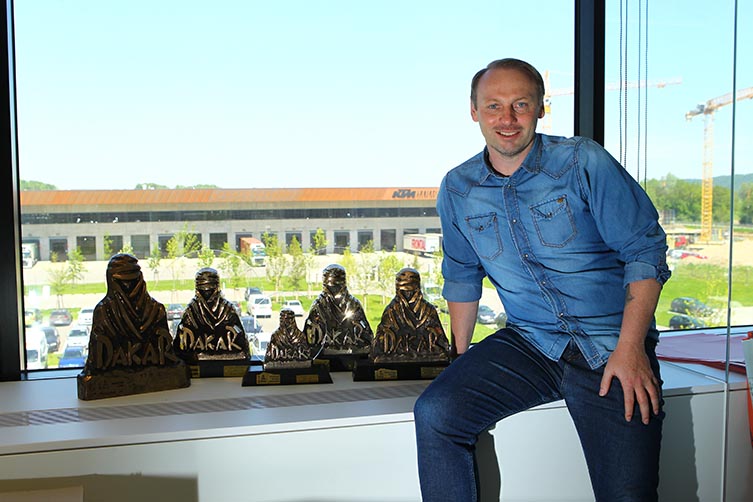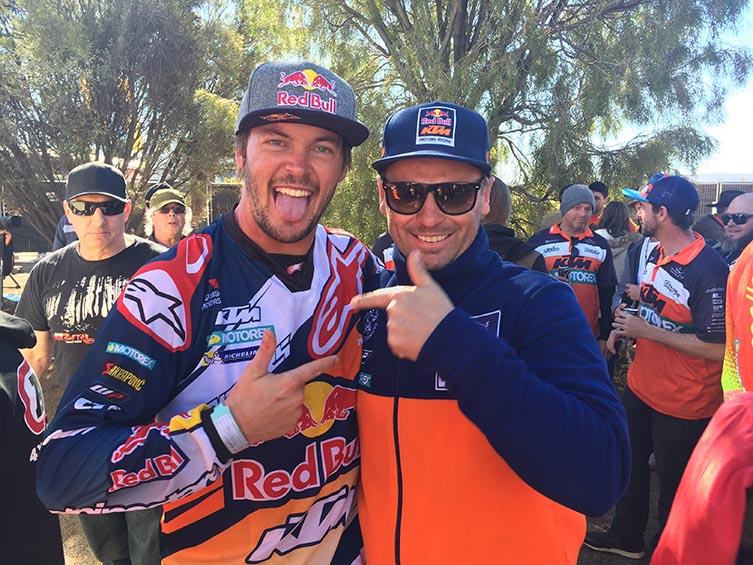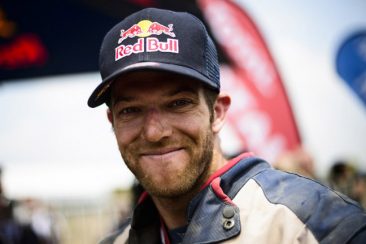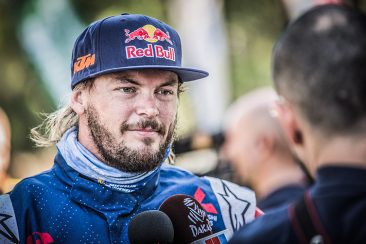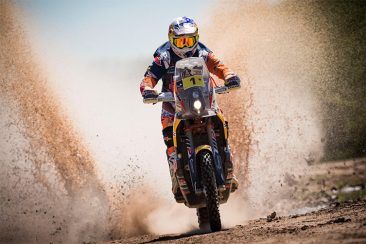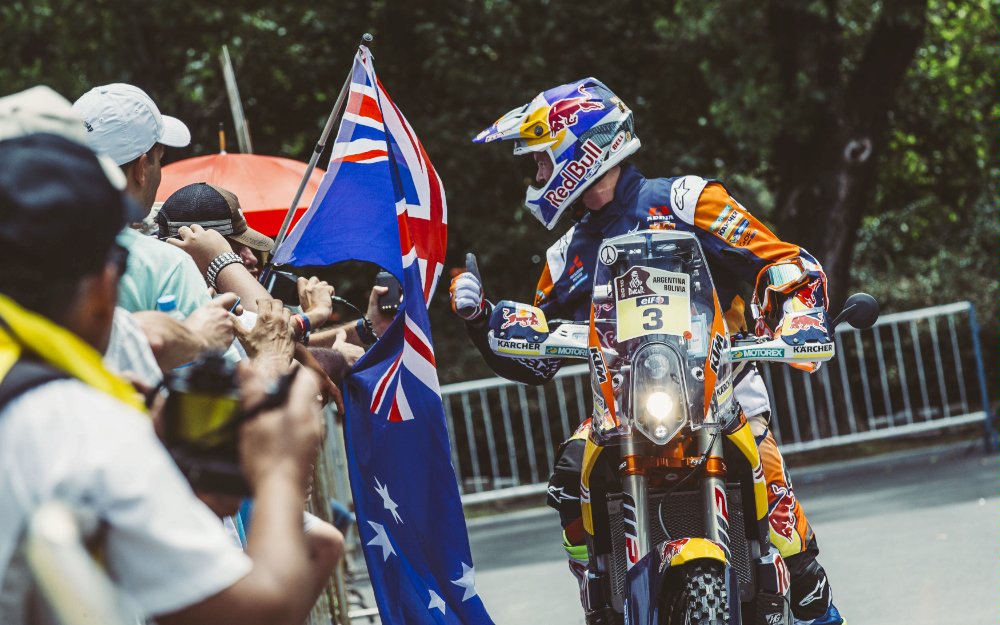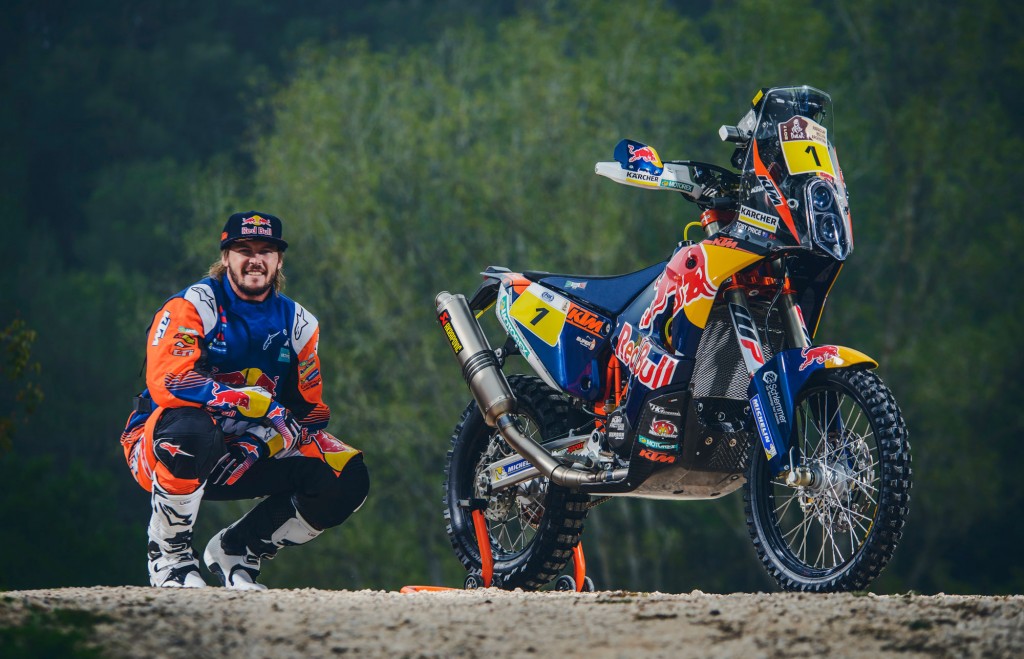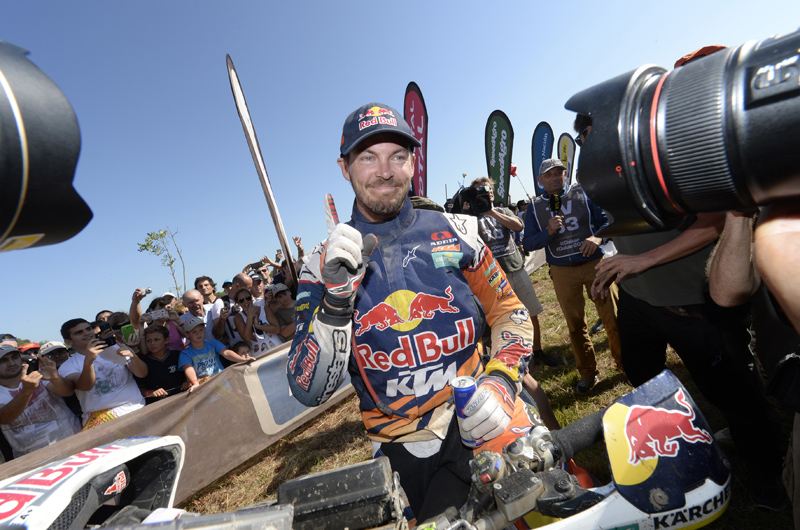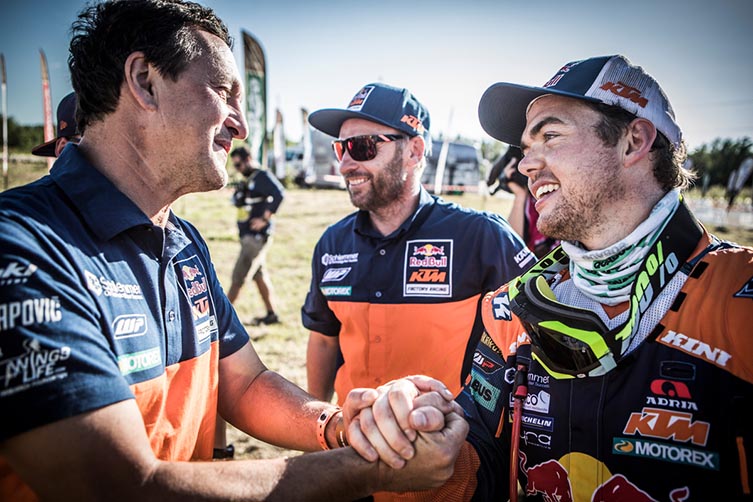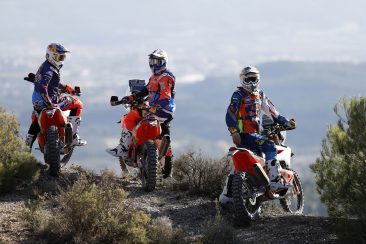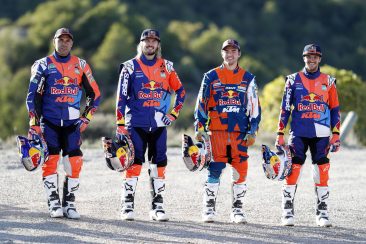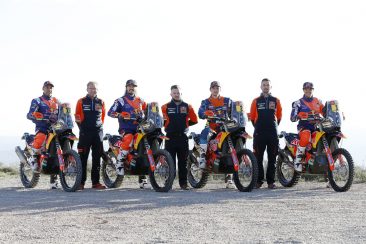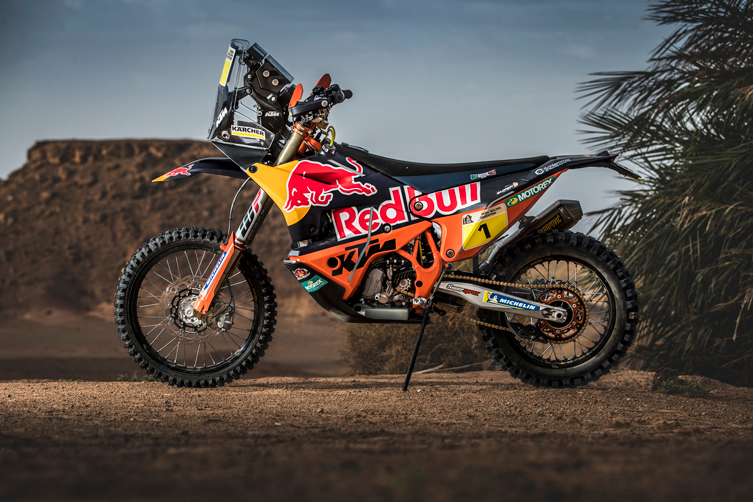Words: Andy Wigan | Photos: Marcin Kin, Sebas Romero, Larissa Redinger
Alex Doringer is the man behind the Dakar Rally’s longest win-streak; an Austrian bloke who, out of his own pocket, funded Australia’s Toby Price his first Dakar. Transmoto’s Andy Wigan spoke with Doringer about the secret to his success, his take on Toby Price, and the KTM versus Honda drama that punctuated the 2017 Dakar Rally.
Following the international media launch for KTM’s 2018-model enduro bikes, I’ve joined KTM Australia’s GM, Jeff Leisk, for a trip to the brand’s HQ in Mattighofen, Austria. Since I was last there in 2013, Mattighofen’s orange empire has literally doubled in size. I take in a fascinating tour of KTM’s production line and engine assembly buildings, and the nearby WP factory. But it’s the contents of KTM’s all-new Motorsport building that I’m really stinging to eyeball. This futuristic structure is home to the Austrian brand’s world championship race teams, including its fledgeling MotoGP outfit, and the most successful race team on the planet, the Red Bull Factory KTM Rally team. I’m here to meet its infamous team manager, Alex Doringer.
When Doringer meets us at reception, it’s obvious he and Leisk go way back. And within minutes, the two are hatching a cunning plan for an early ‘business lunch’ at a local brewery. After I hand over my camera gear and sign a non-disclosure document, Doringer takes Leisk and I on an hour-long tour of the state-of-the-art facility, which culminates in a tantalising first look of KTM’s all-new 450 Rally machine – the bike that Doringer hopes will take his team to a 17th consecutive Dakar win this coming January.
Intrigued by the back-story about how Australia’s Toby Price first connected with the Factory KTM Rally team, how Pricey managed to win Dakar at just his second attempt, and all the drama that surrounded the 2017 Dakar Rally – not least of which were accusations of Honda bending the rules, and Price breaking his leg – I manage to sit the likeable 42-year-old Doringer down and pick his brains. What follows is a transcript of that revealing conversation, which was augmented by a catch-up in the lead-up to the 2018 Dakar Rally.
RIDE KTM: You grew up here in Mattighofen, and rode your pushbike to school past an empty paddock where KTM’s HQ now sits. Was it always your dream to work for KTM?
AD: When I was young, I actually dreamed of being a professional soccer player. But a series of ankle and knee injuries put an end to that dream. Around that time, my grandfather (who had been the Purchase Director at KTM for 30 years, and was hired by Erich Trunkenpolz, the “T” in KTM), suggested that I think about working for KTM. As a local boy, many of my friends raced, so it was difficult not to be involved with KTM. It’s amazing to reflect on how that empty paddock is where KTM’s HQ is now situated, and the fact that KTM now employs 3500 people. I’ve been with KTM now for 16 years.
But not always in the same role, right?
No, that’s right. For the first year, I worked in the office; like a ‘normal’ job [laughs], where I was involved with administration and coordinating things for the spare parts department mainly. But, as I said in my first interview, I was only prepared to do that job for a year because I always wanted to work in the marketing or motorsport areas. It might sound a bit arrogant, but I think they liked the fact I knew what I wanted to do, and that’s why they hired me. Kurt Nicoll, who was International Motorsport Director at the time, then gave me the job of coordinator for enduro racing. That meant I worked with Fabio Farioli and Kari Tiainen, who looked after KTM’s two World Enduro teams, and my job was the consolidate that team effort.
Looking back, was there something about KTM’s culture that made its success – as both a manufacturer and in racing circles – almost inevitable?
Our boss, Mr Stefan Pierer, always had a very clear vision of where the company was going and the timeframe he had in mind for getting there. For me, the goal was always to be part of a winning team, whether that was on the football field or racing motorcycles. I was very lucky because when I started in enduro, it was at a time when we were winning everything. I got to work with incredible riders such as Juha Salminen and David Knight, and I learnt a lot from these guys about what it meant to be a professional sportsman. I think that KTM’s core philosophy of producing a product of the highest quality that is ready to race out of the box has been instrumental in the brand’s success. And KTM has been able to use motorsport as a marketing tool better than any of their rivals. It has not been cheap, but it was the foundation that allowed the company to grow. I think the other secret of KTM’s success is the people at the top, led by Mr Pierer and our Motorsport Director Pit Beirer, who are able to make the right decisions and make them quickly.
You’ve gone on to enjoy a lot of success in your own right, with the Dakar Rally in particular. Did I hear right that you have a 92% win record in the 15 years you’ve been involved with KTM’s EnduroGP and Dakar race teams?
Something like that. As I said, I was very lucky to join KTM’s race effort at a time when they were already dominant in enduro. And we have managed to develop a very successful Dakar Rally program, where we have now won 16 times in a row.
“Kurt Caselli was always telling me how good Toby Price was and that, one day, he should receive the support he deserves.”
Tell us about how you and Toby Price first crossed paths.
The first time I heard about Toby Price was when KTM’s General Manager in Australia, Jeff Leisk, emailed me and asked if KTM’s factory team could help support Toby at a World Enduro round he wanted to race in Europe in 2012. I had heard a lot about Toby’s talent, so we were happy to accommodate that. And I’ll always remember first meeting Toby at the airport in France because it was a very cold October day, and here was this big Australian guy in shorts and a T-shirt and just one set of riding gear in his gearbag. That left a lasting positive impression for me, and when I watched Toby ride in person, it was clear that he was a very, very talented rider. I should also mention Ben Grabham, who has been both a teammate and team manager for Toby, and who was very unlucky not to do better in his own two Dakar Rallys (people forget that, when Grabbo crashed in the 2014 race, he was in sixth position and not far from the leaders). Grabbo played a big part in the early development of Toby as a rally rider. He let Toby use his own KTM 450 Rally bike in Australia and taught him a lot about navigation and how he needs to approach rally racing.
Kurt Caselli was also a big Toby Price fan, right?
He was. After that 2012 World Enduro in France, I did not meet up with Toby again until the 2014 Six-Day, where he won the E3 class and ran second Outright, but I always kept track of what he was up to via online videos, and through Kurt Caselli, who was spearheading KTM’s Baja race program in America and had become close friends with Toby. When Toby crashed before the Baja race in 2013 and broke his neck, I asked Kurt to come and race the Dakar with us. Kurt was always telling me how good Toby was and that, one day, he should receive the support he deserves. Kurt told me that I needed to find a way to get Toby to race the Dakar Rally for KTM, and that this big Australian would not disappoint me.
You had a very close friendship with Kurt yourself, too.
Yes, I did; just as many people in the KTM family did. Kurt was a very special person not only as a rider, but also as an all-round good guy. And when he passed away after crashing at the 2013 Baja 1000, it was a very difficult time. After the funeral, I remember saying to my girlfriend that I’d promised Kurt I would help Toby race the Dakar Rally. And that’s exactly what happened in 2015, when Toby came third on debut.
Is it true that you helped Toby personally that year, out of your own finances?
Yes, I felt I had a commitment to honour my promise to my good friend, Kurt Caselli. I also had a very good feeling about Toby’s ability to do well at Dakar. I knew that Toby would fit into the Dakar environment well, just as Kurt had. Sadly, both my grandparents passed away in the space of a year in 2014, but with the help of the money I received from them, I rented a bike from KTM and made sure KTM’s satellite team had a spot for Toby, along with a motorhome, a good mechanic and anything else he needed. All up, I think it cost me around 70,000 Euro [$108,000 AUD].
“From a riding style point of view, Toby Price is a mix of Cyril Despres and Kurt Caselli. And for a big, strong rider, he is very gentle on the bike.”
When Toby ran third on debut, did it surprise you?
My objective for Toby at that 2015 Dakar was to give him the opportunity to learn and show his potential. Finishing on the podium definitely showed his potential. But for any newcomer to win a stage at the Dakar, that really demonstrates their ability. And both Toby and Kurt managed to do that in their first Dakar. That first year with Toby, the goal was to keep him calm; to make him understand he did not need to race 100 percent each day, and to take things step by step. Toby was very smart. He spoke a lot with Marc Coma that year and learned about what it takes to do well at the Dakar Rally. So in the end, what I did worked for KTM and for Toby, who got a full factory deal for the following year.
Were you aware before that 2015 Dakar that Marc Coma would announce his retirement after the win?
I have been close to Marc for many years, and I was aware that he felt he did not have anything more to prove. He had not been talking about retirement, but I thought he might have another year in him. I am happy that Marc found his position being involved in the sport he dominated, and he is doing and awesome job.
Would Toby have got that factory deal in 2016 if Coma had not retired?
Before Marc’s retirement, there was a factory ride available for Toby, but it was with Husqvarna. So when Marc retired, it freed up the position with KTM, which I was happier about. I’m sure my Australian KTM mates were happier about that, too [laughs].
When Toby won the following year, in 2016, it felt like he managed the entire race like a seasoned Dakar vet.
Toby’s performance was very professional and well managed. Toby is a guy who knows how to work effectively in a team environment. If there is something that needs improving on the bike, he is very good at communicating that to the team. Rather than complaining, it’s a collaborative effort. And he appreciates the small things. For example, one day at the 2016 Dakar, instead of the usual pasta meal, I organised some pizzas and beer for the team. Just one beer for Toby, but it was something he appreciated in a different way to most. He sees the team as a family who works together to find solutions. Also, in 2016, Toby was able to understand how to use his incredible talent on the bike. He could understand the difference between a stage when he could push and win by one minute, and a stage when he could push and win by 10 minutes. That is the key for a great Dakar rider, and it is something he learned very, very quickly.
“Watching Toby race Finke helped me understand how his strength and technique translates so well onto the larger, heavier Dakar bike.”
Navigation is usually the skill that separates the experienced Dakar guys from the newcomers. And yet, in just his second Dakar, it seemed that navigation was one of Toby’s great strengths.
There are not many riders who understand the total picture painted by the road book and the notes that accompany it. But just like Despres and Coma, Toby was able to visualise what the road book was telling him. He learned this skill probably quicker than any rider I have seen in the past. And because he has so much talent on the bike, everything is slowed down. This gives him the time to process the road book and navigate accurately.
You’ve been involved with many great enduro and Dakar champions. What makes Toby Price stand out?
Toby is so stable on the bike because he is big and strong and he uses his legs and body weight so effectively. And he sits down in situations where other riders would be standing. When I came to Australia to watch Toby at Finke Desert Race, I got the opportunity to study his technique from the helicopter for a long time. I saw that, even if he comes into a corner or rough section too fast, he is able to drive the rear wheel into the ground, and that lets it maintain traction and track straight. At Finke, it was amazing to see how talented he is on the bike, and it helped me understand how his technique translates so well onto the larger, heavier Dakar bike. The other incredible thing about Toby is that he looks after the machine. He is very gentle on the bike. For instance, we would fit a new clutch to Marc Coma’s bike after every day of the Dakar. But with Toby, we only replaced it once in 2016. And that was a precaution rather than because it was worn. Cyril Despres was the only other rider I can recall who is similarly gentle on the bike. But from a riding style point of view, Toby is a mix of Despres and Caselli.
What did it feel like for you when Toby won that 2016 Dakar?
It was so special. I thought a lot about Kurt Caselli and my promise to him that I’d support Toby at Dakar. And here we were; we’d done it. Because Kurt, me and Toby were all such good friends, it was very, very emotional. I also know that Toby thought about Kurt a lot during the race, and drew on that when he needed strength.
And for Toby?
I think winning the race was difficult for Toby to get his head around fully because of how much travel and media attention it meant for him. As the first English-speaking rider in 10 years to win the Dakar – and the first Australian ever – it was a unique and very special achievement. That first two months after the race was relentless and almost killed him, but I think he handled it all in a very professional way.
You talk a lot about the KTM team’s ‘Dakar philosophy’. Explain that.
The Dakar is such a long race, so approaching it with a certain mindset is very important. Having the fastest bike and best riders is never enough. When we go to the Dakar, we prepare ourselves for a three-week journey that we know will be very difficult for the riders and the entire team. We know we will encounter extremes of weather, altitude and temperature. We know that we will have very little sleep. And according to previous statistics, we know that 50% of our riders won’t finish. We focus on being good at trouble-shooting, and on making sure our riders remain calm and focused, in spite of the fatigue they will be feeling. But we are not there to instruct our riders; we are there to cooperate with them and find solutions. As KTM has won 16 consecutive Dakars, people always ask me who our biggest challenge will come from. My answer is always the same: our biggest challenge is Dakar itself. It’s a challenge for the team, the rider, the bikes, everything. The team that can find the most effective solutions the quickest will be the team who succeeds. So, yes, it is a philosophy. Even before we head to the Dakar, we make sure everyone in the team has dealt with any personal or family issues. That way, without distractions, we can be focused on what we need to do. We remain calm and we stick together as a team. The team is more important than the individual. Our team is amazing and I am so proud and honoured to be a small part of it. We’re mates with the same DNA and passion, and pockets full of experience.
After winning, you actually visited Australia to watch Toby race the Finke Desert Race. How was that experience?
It was my first time to Australia, and it was an amazing experience. I was there for only four days and I spent most of that time around Alice Springs. I got to ride in the chopper and do some Aussie-style desert camping, and I followed the tradition introduced by my mate, Jeff Leisk, and drank plenty of alcohol to warm up around a campfire with very good people. Felt like home for me. I had seen videos of Toby riding the Finke, but to watch it in person was something different all together. In addition to fully appreciating how talented Toby is on the bike, that trip to Finke made me realise how many talented riders Australia has; even amateur riders because so many of them obviously grow up racing in a fast desert environment. Before coming to Finke, I expected a Baja-style event. But I can tell you Finke is way wilder than Baja. It’s crazy fast and crazy rough.
Let’s talk about the 2017 Dakar. Sam Sunderland’s victory gave KTM its 16th win on the trot. But does that long-standing success add to the team’s pressure?
No. Our team never operates as if we are race favourites. Yes, with Toby and Sam Sunderland, we knew we had a very good chance. But there are so many variables at Dakar, so we always go there as well prepared as we possibly can. At Dakar, you have to find solutions to problems that arise every day, so you cannot go there thinking you already have answers for everything. And it’s true that luck can also play a part. Toby had some bad luck and was out of the race after four days this year.
Is there more to the story about Price breaking his leg on Stage 4 than we know? You protested the HRC Honda team for refuelling illegally on that same stage, and there’s been rumour that the two are somehow connected.
That day was always going to be critical with fuel because it was a very long stage heading into Bolivia. So we began the day with our bikes’ fuel tanks completely full. It was not ideal, because the first stage was very rough, but we had no choice. No riders did. That morning, Toby could not understand how Honda’s Joan Barreda could pull away from him in the rough terrain. Later that day, we discovered that the red bikes were running about 12 litres less fuel than us early on that stage, which allowed them to handle much better through the rough riverbed. Toby therefore had to push very, very hard in that section. And that is where he crashed and broke his leg. As I’ve said, there is always an element of luck at the Dakar. Okay, it is possible that Barreda may still be faster with more fuel onboard. I simply know that it was a disadvantage for us to carrying more fuel. Whether Toby crashed as a result of pushing too hard to keep up with a bike carrying a much lighter fuel load, I cannot say for sure.
And then, later that day, the three HRC Honda riders each copped a one-hour penalty for refuelling their bikes outside the race’s designated refuelling areas.
To my way of thinking, that penalty was not big enough. It might not be the case that the Honda riders went to this fuel station to intentionally break the rules. But all three riders clearly recognised that they were running out of fuel and had no choice but to refuel at this time. I have photographic proof of this. To me, that suggests they made a fuel miscalculation. And when you make a mistake and need extra help to continue in the race – help that is not allowed by the race’s rules – then you should expect receive a penalty.
The Honda team disagreed with the penalty, arguing that the rulebook invited different interpretations, and that they were “moral victors of the Dakar”. What’s your take on that?
I think the refuelling rule was very clear. And that’s how the race organisers saw it. As I said, I think the one-hour penalty was not severe enough for what they did. Throughout the event, the organisers were asking me to withdraw my protest against the Honda team. I finally did withdraw it, but only after I was certain that KTM riders would fill all three positions on the podium.
There seemed to be more than the average dose of drama at the 2017 Dakar.
For us, yes. At the time Toby got injured, I was busy protesting Honda and juggling a whole lot of logistical problems caused by the crazy weather. Toby went to the same hospital in Bolivia that Matthias Walkner went to the previous year when he broke his leg, so we were lucky that we had some contacts there who made sure Toby got a good treatment and people to help him with translation. I felt bad because it took us a full day before we could go and see Toby in hospital, and by that time, he also had some issues with his lungs. But the Dakar does not stop. We had one eye on Sam Sunderland who was leading the race, and the other on making sure Toby got the best treatment.
For the upcoming 2018 Dakar, you’re armed with the 2016 and 2017 champs – Toby Price and Sam Sunderland – and an all-new KTM 450 Rally machine that has proved to be fast, reliable, light and stable in the lead-up rallies.
Yes, this new-generation bike has been in development for a few years; led by our Technical Director Stefan Huber and his team, in cooperation with Habsburg Philipp’s R&D team, and Gerald Kiska and his design and engineering team. Yes, it is very different to its predecessor. As you say, it is lighter and more nimble to suit the fact Dakar is a more technical race these days. The engine is lighter, smaller, more balanced and faster. With the bike’s fuel cells being much closer to the centre of the bike, it handles a lot better in rough terrain. Input from our team riders has ensured the riding position is more comfortable, plus we have done a lot of testing with different windshields. We’ve also better integrated the navigation equipment into the headlight mask to improve the rider’s view of the road book and instruments, and made it more crash-resistant. This new bike feels like a big step forward. It will help our guys go faster, especially on technical sections, because that is how you win the Dakar. In fact, it has really motivated our riders for 2018.
So all the ingredients are there, but we’re not allowed to suggest that KTM goes into the 2018 event as favourites to win its 17th consecutive Dakar, right?
Right [laughs]! But I can say we are very well prepared. Remember also that KTM’s Rally program means we also support a lot of customers. At the 2017 Dakar, we had 73 entries on KTM customer bikes, and 52 of them finished the Dakar. It’s amazing to think that we only bring one truck full of spare parts and yet manage to support all of these guys. It’s a unique amateur rider support program that was the brainchild of Heinz Kinigadner and Hans Trunkenpolz many years ago, and one that we are very proud of.

